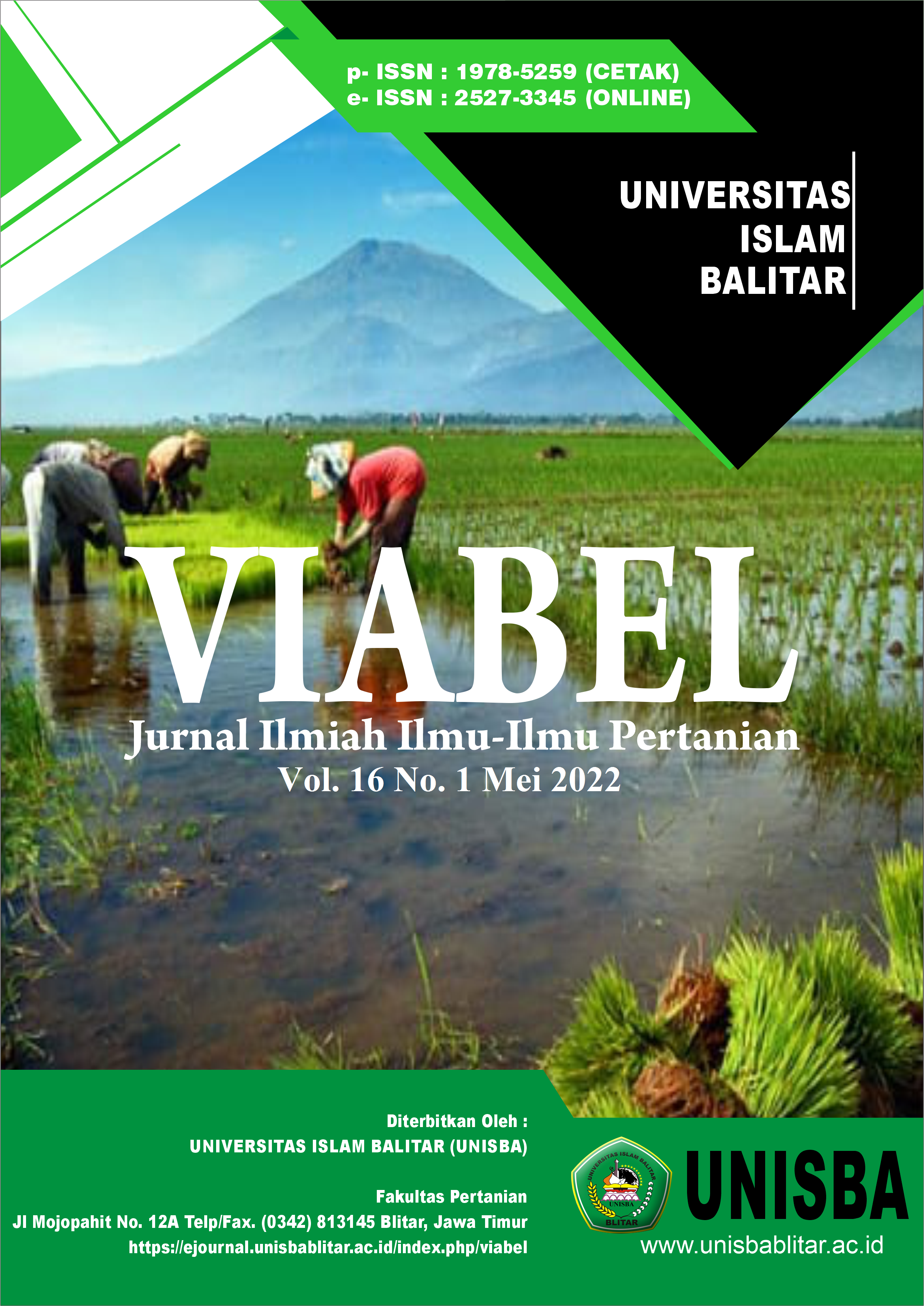The PERFORMANSI PADI GREEN SUPER RICE YANG ADAPTIF PADA LAHAN SAWAH TADAH HUJAN
DOI:
https://doi.org/10.35457/viabel.v16i1.1776Keywords:
Green Super Rice, Rainfed Rice Fields, ProductivityAbstract
Green Super Rice (GSR) is a rice plant that can be cultivated on land that is nutrient efficient, has high yields and is resistant to biotic and abiotic stresses. GSR planting is expected to have adaptability and good yields in conditions of infertile rice fields, often experiencing drought, uncertainty in air supply, low fertility, and disease attacks. The aim of the study was to see the performance of adaptive Green Super Rice in rainfed rice fields. The GSR rice lines will be planted in Bireun, Indonesia. This study used a one-factor Randomized Block Design (RAK) with 3 replications. The treatment factors that were tried were 6 GSR rice lines, the F8 line, from a cross between the Sikuneng variety from Bireun and IRBB27. As a comparison, the national superior variety Inpari 42 was used. There were 21 experiments and each experiment consisted of 2 plant units, one plant as the sample plant. GSR lines which were selected at the Aceh Rice Research Center in the previous planting season. The comparison variety used was Inpari 42. Seedlings aged 21 days after sowing from each line and comparison varieties were planted 1-3 seedlings per hole in a plot measuring 2m x 5m with a spacing of 20 cm x 20 cm. Irrigation relies on rain and water pumps from rainwater reservoirs. variables of plant height (cm), number of productive tillers, heading date or 50% flowering age (HSS), number of filled grain, percentage of filled grain(%), weight of 1,000 grains(g), and yield(t/ Ha).
Downloads
References
FAO (Food and Agriculture Organization), (2018) FAOSTAT database Food and Agriculture Organization, Rome. http://www.fao.org/faostat/en/#data/QC/. Accessed:26 Januari 2021.
Efendi, (2012) Selection of acehnese germplasm of rice (oryza sativa l.) using sri approach in the post-tsunami affected area of aceh province indonesia, paper presented at the 2nd annual international conference unsyiah and 8th imt-gt uninet biosciences conference, Syiah Kuala University, Banda Aceh, 22-24 November 2012.
Elizabeth R, (2018) Strategi pencapaian diversifikasi dan kemandirian pangan: Antara harapan dan kenyataan.
Fischer KS, Fukai, (2003) How rice responds to drought, In: Fischer KS, R. Lafitte S, Fukai G, Altin, Hardy (eds) Breeding Rice For Drought-Prone Environments. International Rice Research Institute. Manila, p 32-36.
Gago C, Pasolon Y B, Boer D, (2015) Keragaman agronomis dan morfologis padi gogo lokal sultra dan timor-leste ditanam pada kondisi air sub-optimal dan optimal. Berkala Penelitian Agronomi 6 (1): 25-35.
Huang L, Sun F, Yuan S, Peng S, Wang F, (2018) Responses of candidate green super rice and super hybrid rice varieties to simplified and reduced input practice. Field Crops Research 218: 78-87.
Husana Y, (2010) Pengaruh penggunaan jarak tanam terhadap pertumbuhan dan produksi padi sawah (Oryzasativa L.) arietas IR42 dengan metode SRI (System of Rice Intensification), Jurnal Jurusan Agroteknologi, Fakultas Pertanian. Universitas Riau.
Ilham M, Bakhtiar B, Efendi, (2019) Respon pertumbuhan dan hasil galur padi F3 hasil persilangan sikuneng dengan Irbb27 sebagai kandidat green super rice (GSR) pada kondisi aerobik. Jurnal Ilmiah Mahasiswa Pertanian 4 (2): 41-50.
Maxwell S L, Butt N, Maron M, McAlpine C A, Chapman S, Ullmann A, Watson J E, (2019) Conservation implications of ecological responses to extreme weather and climate events. Diversity and Distributions 25 (4): 613-625.
Nadapdap H J, (2016) Dinamika produktivitas padi, jagung, dan kedelai di pulau jawa, indonesia productivity dynamic of rice, corn, and soybean in java, Indonesian. Jurnal Penelitian Pertanian Terapan Vol 17 (1):1-10.
Nainggolan K, Badan Pertahanan Pangan, (2016) Ketahanan dan stabilitas pasokan, permintaan, dan harga komoditas pangan.
Novia R A, Satriani R, (2020) Analisis efisiensi teknis usahatani padi sawah tadah hujan di kabupaten banyumas. Mediagro 16 (1).
Rusdiana S, Maesya A (2017) Pertumbuhan ekonomi dan kebutuhan pangan di Indonesia. Agriekonomika 6 (1): 12-25.
Ruminta R, Wahyudin A, Sakinah S, (2017) Respon pertumbuhan dan hasil tanaman padi terhadap jarak tanam pada lahan tadah hujan dengan menggunakan pengairan intermittent. Agrin 21 (1).
Saliem H P, Ariani M, (2016) Ketahanan pangan, konsep, pengukuran dan strategi.
Seck P A, Diagne A, Mohanty S, Wopereis M C, (2012) Crops that feed the world 7. Rice Food security 4 (1): 7-24.
Setiawan S, Radian R, Abdurrahman T, (2020) Pengaruh jumlah dan umur bibit terhadap pertumbuhan dan hasil padi pada lahan sawah tadah hujan. Agrifor, Jurnal Ilmu Pertanian dan Kehutanan 19 (1): 33-44.
Susanto U, (2017) Penelitian dan pengembangan varietas green super rice di indonesi, Balai Penelitian Tanaman Padi. Jawa Barat.
Suyamto, Saeri M, Saraswati DP, Robi’in, (2015) Verifikasi dosis rekomendasi pemupukan hara spesifik lokasi untuk padi varietas hibrida. Penelitian Pertanian Tanaman Pangan 34 (3):165-173.
Downloads
Published
Issue
Section
License
Copyright (c) 2022 VIABEL: Jurnal Ilmiah Ilmu-Ilmu Pertanian

This work is licensed under a Creative Commons Attribution-ShareAlike 4.0 International License.
Authors who publish with this journal agree to the following terms:
- Copyright on any article is retained by the author(s).
- The author grants the journal, right of first publication with the work simultaneously licensed under a Creative Commons Attribution License that allows others to share the work with an acknowledgment of the work’s authorship and initial publication in this journal.
- Authors are able to enter into separate, additional contractual arrangements for the non-exclusive distribution of the journal’s published version of the work (e.g., post it to an institutional repository or publish it in a book), with an acknowledgment of its initial publication in this journal.
- Authors are permitted and encouraged to post their work online (e.g., in institutional repositories or on their website) prior to and during the submission process, as it can lead to productive exchanges, as well as earlier and greater citation of published work.
- The article and any associated published material is distributed under the Creative Commons Attribution-ShareAlike 4.0 International License










.png)




